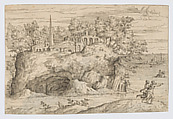View of an Island with Antique Ruins (The Abduction of Europa), from: Imagini Favolose
Giovanni Battista Pittoni the Elder Italian
Not on view
This etching depicts an antique landscape with at its center an island filled with ruins of Classical architecture. In the foreground at right, two figures are depicted on a different shore, who are seemingly running away. On the right side of the sheet, in the background, another island is depicted, reminiscent of those in the Veneto, and in the water the Greek goddess Europa is being carried away by Zeus in the guise of a bull. The print was made by Giovanni Battista Pittoni the Elder, and is part of a series depicting myths from Classical Antiquity. They were published in 1585 by Francesco Ziletti under the title "Imagini Favolose", but had likely been published previously by Pittoni himself. Pittoni is principally known for his prints depicting landscapes, some after the Venetian artist Titian, but many seemingly of his own design. His prints containing views of ancient Roman architecture were used in Vincenzo Scamozzi’s "Discorsi Sopra L’Antichita di Roma", which is arguably one of Pittoni’s best-known achievements. The "Imagini Favolose" are less famous, but speak to his virtuosity in this particular genre. While the title of the print series indicates that the ancient myths are the subject of the prints, in most cases the landscapes are foregrounded by the artist.
On the verso of the sheet part of a sixteenth-century drawing in pen and ink with wash is visible. The subject of the drawing is close to that of the print and shows several figures in a landscape with a grotto. The unidentified draftsman has made annotations to indicate the use of color to work out the landscape in paint.
This image cannot be enlarged, viewed at full screen, or downloaded.
This artwork is meant to be viewed from right to left. Scroll left to view more.





